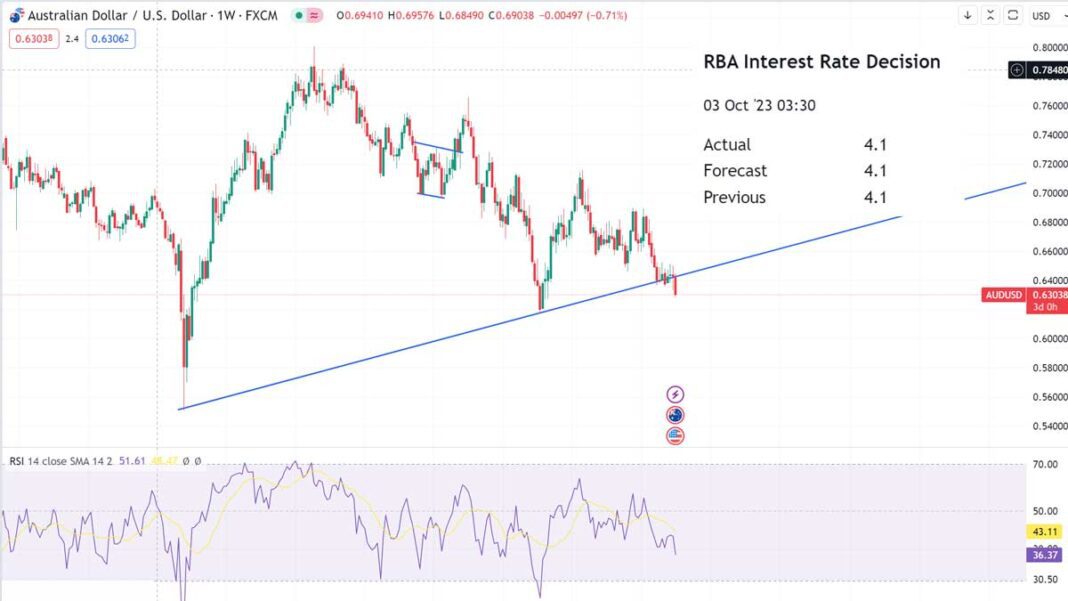The current price of AUD/USD stands at 0.6304, with the US Dollar continuing its upward surge, driven by fresh multi-year highs in US yields. As anticipated, the Reserve Bank of Australia (RBA) maintained unchanged interest rates, while US economic data exceeded expectations.
This has left the AUD/USD pair under significant pressure, resulting in a drop to its lowest point in 11 months, falling below the critical level of 0.6300. The intensified demand for the US Dollar, combined with risk-averse sentiment in the market, contributed to the pair’s decline.
The RBA, in line with expectations, decided to keep the key interest rate steady at 4.10%. The statement accompanying this decision displayed only minor alterations compared to the previous one. During her inaugural meeting as Governor, Michele Bullock did not spring any surprises.
Given the current state of Chinese economic data and the global growth outlook, it seems unlikely that the RBA will raise interest rates again this year. The forthcoming inflation data will play a pivotal role in the RBA’s decision-making process at the next meeting, scheduled for November 7. Investors are looking forward to the release of the Monthly Consumer Price Index and the quarterly inflation report on October 25.
The predominant factor influencing AUD/USD remains the strength of the US Dollar. The greenback has gained momentum across the board, especially following the release of the JOLTS Job Opening report, which surpassed expectations. More US employment data is set to be unveiled on Wednesday, including the ADP Private Payrolls. Additionally, the market will watch for Factory Orders and the final reading of the Global S&P PMI. As of Tuesday, the US 10-year Treasury yield reached 4.79%, marking new cycle highs. The confluence of a cautious market, favorable US data, and higher yields continues to bolster the US Dollar’s rally.
The key factor influencing the AUD/USD pair remains the strength of the US Dollar, which has seen significant gains. Positive US economic data, such as the JOLTS Job Opening report, has contributed to the Dollar’s upward momentum, along with rising US Treasury yields, now at cycle highs.
Short-term technical analysis for AUD/USD indicates that the pair is on the cusp of recording its lowest daily close in 11 months, well below the 0.6350 threshold. On the daily chart, technical indicators have shifted to a bearish stance, with Momentum dropping below the midpoint and the Relative Strength Index (RSI) moving south, though not yet reaching oversold levels. A daily close above 0.6500 would invalidate the bearish outlook.
On the 4-hour chart, the pair is in oversold territory, potentially hinting at consolidation before the Asian session, likely around 0.6300. The Relative Strength Index is starting to reverse from below the 30 mark. While the bias remains downward, with the price comfortably below crucial SMAs (Simple Moving Averages), a period of stabilization before a further descent appears plausible. If 0.6280 is breached, it could pave the way for the next substantial support level at 0.6250. On the upside, immediate resistance is now observed at 0.6330, followed by the 0.6350 zone. A move beyond these levels could alleviate the bearish pressure.
Support levels: 0.6280, 0.6255, 0.6235
Resistance levels: 0.6330, 0.6350, 0.6385
For traders navigating this environment, it’s essential to exercise caution and adopt a risk-aware approach. Here are some safe trading considerations:
- Stay Informed: Keep a close eye on economic data releases, particularly from the US, as they can significantly impact currency movements.
- Risk Management: Implement sound risk management strategies, including setting stop-loss orders to limit potential losses and protect your capital.
- Technical Analysis: Utilize technical indicators and chart analysis to identify potential entry and exit points, but remember that market sentiment can override technical signals.
- Diversification: Avoid putting all your resources into a single trade. Diversify your portfolio to spread risk.
- Stay Updated: Continuously monitor market news and events, as unexpected developments can quickly change the trading landscape.
- Demo Trading: If you’re new to forex or uncertain about a strategy, practice with a demo account before risking real capital.
- Consult Experts: Consider seeking advice or insights from experienced traders or financial experts to make informed decisions.
- Adaptability: Be prepared to adapt your trading strategy as market conditions evolve.
Remember that forex trading involves inherent risks, and there are no guarantees of profits. Prioritize capital preservation and risk management to ensure safe and sustainable trading practices.

